Parameter Optimization of SWMM Model Using Integrated Morris and GLUE Methods
Abstract
:1. Introduction
2. Materials and Methods
2.1. Study Area and Data
2.2. Methods
2.2.1. SWMM Model
2.2.2. Morris Screening Method
2.2.3. GLUE Method
- Step 1—Selecting the likelihood function for the model simulation calculation.
- Step 2—Selecting the initial range of the model parameters and the prior distribution of parameters. The random combination of parameters is then obtained by Latin hypercube sampling.
- Step 3—Simulating the likelihood values of each combination by running the model to obtain the posterior distribution of the parameters.
2.2.4. Coupling Based on Genetic Algorithm
3. Results
3.1. Parameter Sensitivity Analysis
3.2. Uncertainty Analysis of Parameter Value Range
3.3. Parameter Calibration
3.4. Validation Result
4. Discussion
5. Conclusions
- (1)
- The parameter sensitivity analysis results varied with the different objective functions utilized. The sensitive factors are also observed to change with the rainfall intensity. These indicate that it is essential to consider multiple operating conditions in the parameter sensitivity analysis. In addition, the perturbation analysis of multiple modalities shows that the sensitivity of the parameters is highly susceptible to sudden changes among different modalities, and the results of the screening method for a single perturbation modality possess considerable uncertainty.
- (2)
- Although the GLUE method only reduced the range of the values for two parameters in the research, the peak error was reduced by up to 9%. For the optimization of complex model parameters, using sensitivity and uncertainty analysis in combination with each other, satisfactory model simulation results can be achieved.
- (3)
- When the Genetic Algorithm was used to optimize parameter sets with different combinations, the model parameter optimization process varied with the increase in the number of constraints on the fitness function. Compared with constructing the fitness function using a single-objective constraint, the Genetic Algorithm for multi-objective constraints shows a decreasing trend in the overall peak error of the model simulations.
Author Contributions
Funding
Data Availability Statement
Acknowledgments
Conflicts of Interest
References
- Veal, A.J. Climate change 2021: The physical science basis, 6th report. World Leis. J. 2021, 63, 443–444. [Google Scholar] [CrossRef]
- Zhang, L.; Jin, X.; He, C.; Zhang, B.; Zhang, X.; Li, J.; Zhao, C.; Tian, J.; DeMarchi, C. Comparison of SWAT and DLBRM for Hydrological Modeling of a Mountainous Watershed in Arid Northwest China. J. Hydrol. Eng. 2016, 21, 1313. [Google Scholar] [CrossRef]
- Iffland, R.; Förster, K.; Westerholt, D.; Pesci, M.; Lösken, G. Robust Vegetation Parameterization for Green Roofs in the EPA Stormwater Management Model (SWMM). Hydrology 2021, 8, 12. [Google Scholar] [CrossRef]
- Ballinas-González, H.; Alcocer-Yamanaka, V.; Canto-Rios, J.; Simuta-Champo, R. Sensitivity Analysis of the Rainfall–Runoff Modeling Parameters in Data-Scarce Urban Catchment. Hydrology 2020, 7, 73. [Google Scholar] [CrossRef]
- Szeląg, B.; Kiczko, A.; Łagód, G.; De Paola, F. Relationship Between Rainfall Duration and Sewer System Performance Measures Within the Context of Uncertainty. Water Resour. Manag. 2021, 35, 5073–5087. [Google Scholar] [CrossRef]
- Hussain, S.N.; Zwain, H.M.; Nile, B.K. Modeling the effects of land-use and climate change on the performance of stormwater sewer system using SWMM simulation: Case study. J. Water Clim. Chang. 2021, 13, 125–138. [Google Scholar] [CrossRef]
- Cukier, R.I.; Levine, H.B.; Shuler, K.E. Nonlinear sensitivity analysis of multiparameter model systems. J. Phys. Chem. 1977, 81, 2365–2366. [Google Scholar] [CrossRef]
- Lei, J.; Schilling, W. Parameter Uncertainty Propagation Analysis for Urban Rainfall Runoff Modelling. Water Sci. Technol. 1994, 29, 145–154. [Google Scholar] [CrossRef]
- Knighton, J.; White, E.; Lennon, E.; Rajan, R. Development of probability distributions for urban hydrologic model parameters and a Monte Carlo analysis of model sensitivity. Hydrol. Process. 2013, 28, 5131–5139. [Google Scholar] [CrossRef]
- Dong, Q.; Lu, F. Performance Assessment of Hydrological Models Considering Acceptable Forecast Error Threshold. Water 2015, 7, 6173–6189. [Google Scholar] [CrossRef]
- Liu, Z.J.; Li, L.H. An Evaluation Method of Water Quality Based on Improved PSO-BP Network. Adv. Mater. Res. 2013, 846, 1243–1246. [Google Scholar] [CrossRef]
- Zhou, L.; Liu, P.; Gui, Z.; Zhang, X.; Liu, W.; Cheng, L.; Xia, J. Diagnosing structural deficiencies of a hydrological model by time-varying parameters. J. Hydrol. 2022, 605, 127305. [Google Scholar] [CrossRef]
- Confalonieri, R.; Bellocchi, G.; Tarantola, S.; Acutis, M.; Donatelli, M.; Genovese, G. Sensitivity analysis of the rice model WARM in Europe: Exploring the effects of different locations, climates and methods of analysis on model sensitivity to crop parameters. Environ. Model. Softw. 2010, 25, 479–488. [Google Scholar] [CrossRef]
- van der Sterren, M.; Rahman, A.; Ryan, G. Modeling of a lot scale rainwater tank system in XP-SWMM: A case study in Western Sydney, Australia. J. Environ. Manag. 2014, 141, 177–189. [Google Scholar] [CrossRef]
- Sreedevi, S.; Eldho, T.I. A two-stage sensitivity analysis for parameter identification and calibration of a physically-based distributed model in a river basin. Hydrol. Sci. J. 2019, 64, 701–719. [Google Scholar] [CrossRef]
- Lin, J.; Zou, X.; Huang, F. Quantitative analysis of the factors influencing the dispersion of thermal pollution caused by coastal power plants. Water Res. 2020, 188, 116558. [Google Scholar] [CrossRef]
- Freni, G.; Mannina, G.; Viviani, G. Uncertainty in urban stormwater quality modelling: The influence of likelihood measure formulation in the GLUE methodology. Sci. Total Environ. 2009, 408, 138–145. [Google Scholar] [CrossRef]
- Zhang, H.; Chang, J.; Zhang, L.; Wang, Y.; Ming, B. Calibration and uncertainty analysis of a hydrological model based on cuckoo search and the M-GLUE method. Arch. Meteorol. Geophys. Bioclimatol. Ser. B 2018, 137, 165–176. [Google Scholar] [CrossRef]
- Liang, Y.; Cai, Y.; Sun, L.; Wang, X.; Li, C.; Liu, Q. Sensitivity and uncertainty analysis for streamflow prediction based on multiple optimization algorithms in Yalong River Basin of southwestern China. J. Hydrol. 2021, 601, 126598. [Google Scholar] [CrossRef]
- Muronda, M.T.; Marofi, S.; Nozari, H.; Babamiri, O. Uncertainty Analysis of Reservoir Operation Based on Stochastic Optimization Approach Using the Generalized Likelihood Uncertainty Estimation Method. Water Resour. Manag. 2021, 35, 3179–3201. [Google Scholar] [CrossRef]
- Chen, X.; Yang, T.; Wang, X.; Xu, C.-Y.; Yu, Z. Uncertainty Intercomparison of Different Hydrological Models in Simulating Extreme Flows. Water Resour. Manag. 2012, 27, 1393–1409. [Google Scholar] [CrossRef]
- Moges, E.; Demissie, Y.; Larsen, L.; Yassin, F. Review: Sources of Hydrological Model Uncertainties and Advances in Their Analysis. Water 2020, 13, 28. [Google Scholar] [CrossRef]
- Xue, F.; Tian, J.; Wang, W.; Zhang, Y.; Ali, G. Parameter Calibration of SWMM Model Based on Optimization Algorithm. Comput. Mater. Contin. 2020, 65, 2189–2199. [Google Scholar] [CrossRef]
- Xu, Z.; Xiong, L.; Li, H.; Xu, J.; Cai, X.; Chen, K.; Wu, J. Runoff simulation of two typical urban green land types with the Stormwater Management Model (SWMM): Sensitivity analysis and calibration of runoff parameters. Environ. Monit. Assess. 2019, 191, 343. [Google Scholar] [CrossRef]
- Behrouz, M.S.; Zhu, Z.; Matott, L.S.; Rabideau, A.J. A new tool for automatic calibration of the Storm Water Management Model (SWMM). J. Hydrol. 2019, 581, 124436. [Google Scholar] [CrossRef]
- Li, S.; Wang, Z.; Wu, X.; Zeng, Z.; Shen, P.; Lai, C. A novel spatial optimization approach for the cost-effectiveness improvement of LID practices based on SWMM-FTC. J. Environ. Manag. 2022, 307, 114574. [Google Scholar] [CrossRef]
- Perin, R.; Trigatti, M.; Nicolini, M.; Campolo, M.; Goi, D. Automated calibration of the EPA-SWMM model for a small suburban catchment using PEST: A case study. Environ. Monit. Assess. 2020, 192, 1–17. [Google Scholar] [CrossRef]
- Eckart, K.; McPhee, Z.; Bolisetti, T. Multiobjective optimization of low impact development stormwater controls. J. Hydrol. 2018, 562, 564–576. [Google Scholar] [CrossRef]
- Gironás, J.; Roesner, L.A.; Rossman, L.A.; Davis, J. A new applications manual for the Storm Water Management Model (SWMM). Environ. Model. Softw. 2010, 25, 813–814. [Google Scholar] [CrossRef]
- Liang, J.; Hu, Z.; Liu, S.; Zhong, G.; Zhen, Y.; Makhinov, A.N.; Araruna, J.T. Residual-Oriented Optimization of Antecedent Precipitation Index and Its Impact on Flood Prediction Uncertainty. Water 2022, 14, 3222. [Google Scholar] [CrossRef]
- Annus, I.; Vassiljev, A.; Kändler, N.; Kaur, K. Automatic Calibration Module for an Urban Drainage System Model. Water 2021, 13, 1419. [Google Scholar] [CrossRef]
- Lee, J.; Kim, J.; Lee, J.M.; Jang, H.S.; Park, M.; Min, J.H.; Na, E.H. Analyzing the Impacts of Sewer Type and Spatial Distribution of LID Facilities on Urban Runoff and Non-Point Source Pollution Using the Storm Water Management Model (SWMM). Water 2022, 14, 2776. [Google Scholar] [CrossRef]
- Shi, R.; Zhao, G.; Pang, B.; Jiang, Q.; Zhen, T. Uncertainty Analysis of SWMM Model Parameters Based on GLUE Method. J. China Hydrol. 2016, 36, 1–6. [Google Scholar]
- Chang, X.; Xu, Z.; Zhao, G.; Li, H. Sensitivity analysis on SWMM model parameters based on Sobol method. J. Hydro-Electr. Engineering. 2018, 37, 59–68. [Google Scholar]
- Li, M.; Yang, X. Global Sensitivity Analysis of SWMM Parameters Based on Sobol Method. China Water Wastewater 2020, 36, 95–102. [Google Scholar]
- Rossman, L.A.; Simon, M.A. Storm Water Management Model User's Manual Version 5.2; EPA: Cincinnati, OH, USA, 2022. [Google Scholar]
- Morris, M.D. Factorial Sampling Plans for Preliminary Computational Experiments. Technometrics 1991, 33, 161–174. [Google Scholar] [CrossRef]
- Zádor, J.; Zsély, I.; Turányi, T. Local and global uncertainty analysis of complex chemical kinetic systems. Reliab. Eng. Syst. Saf. 2006, 91, 1232–1240. [Google Scholar] [CrossRef]
- Lenhart, T.; Eckhardt, K.; Fohrer, N.; Frede, H.-G. Comparison of two different approaches of sensitivity analysis. Phys. Chem. Earth Parts A/B/C 2002, 27, 645–654. [Google Scholar] [CrossRef]
- Beven, K.; Binley, A. The future of distributed models: Model calibration and uncertainty prediction. Hydrol. Process. 1992, 6, 279–298. [Google Scholar] [CrossRef]
- Mirzaei, M.; Huang, Y.F.; El-Shafie, A.; Shatirah, A. Application of the generalized likelihood uncertainty estimation (GLUE) approach for assessing uncertainty in hydrological models: A review. Stoch. Hydrol. Hydraul. 2015, 29, 1265–1273. [Google Scholar] [CrossRef] [Green Version]
- Thorndahl, S.; Beven, K.; Jensen, J.; Schaarup-Jensen, K. Event based uncertainty assessment in urban drainage modelling, applying the GLUE methodology. J. Hydrol. 2008, 357, 421–437. [Google Scholar] [CrossRef] [Green Version]
- Lee, D.; Beste, M.T.; Anderson, N.R.; Koretzky, G.A.; Hammer, D.A. Identifying Key Pathways and Components in Chemokine-Triggered T Lymphocyte Arrest Dynamics Using a Multi-Parametric Global Sensitivity Analysis. Cell. Mol. Bioeng. 2019, 12, 193–202. [Google Scholar] [CrossRef] [PubMed]
- Saltelli, A.; Ratto, M.; Andres, T.; Campolongo, F.; Cariboni, J.; Gatelli, D.; Saisana, M.; Tarantola, S. Global Sensitivity Analysis. The Primer, 1st ed.; John Wiley & Sons Ltd: West Sussex, UK, 2007; pp. 1–292. [Google Scholar]
- Dotto, C.B.; Mannina, G.; Kleidorfer, M.; Vezzaro, L.; Henrichs, M.; McCarthy, D.T.; Freni, G.; Rauch, W.; Deletic, A. Comparison of different uncertainty techniques in urban stormwater quantity and quality modelling. Water Res. 2012, 46, 2545–2558. [Google Scholar] [CrossRef]
- Zhang, W.; Li, T. The Influence of Objective Function and Acceptability Threshold on Uncertainty Assessment of an Urban Drainage Hydraulic Model with Generalized Likelihood Uncertainty Estimation Methodology. Water Resour. Manag. 2015, 29, 2059–2072. [Google Scholar] [CrossRef]
- Kang, C.; Liu, Z.; Shirinzadeh, B.; Zhou, H.; Shi, Y.; Yu, T.; Zhao, P. Parametric optimization for multi-layered filament-wound cylinder based on hybrid method of GA-PSO coupled with local sensitivity analysis. Compos. Struct. 2021, 267, 113861. [Google Scholar] [CrossRef]
- Peng, Z.; Jin, X.; Sang, W.; Zhang, X. Optimal Design of Combined Sewer Overflows Interception Facilities Based on the NSGA-III Algorithm. Water 2021, 13, 3440. [Google Scholar] [CrossRef]
- Randall, M.; Sun, F.; Zhang, Y.; Jensen, M.B. Evaluating Sponge City volume capture ratio at the catchment scale using SWMM. J. Environ. Manag. 2019, 246, 745–757. [Google Scholar] [CrossRef]
- Baek, S.-S.; Choi, D.-H.; Jung, J.-W.; Lee, H.-J.; Lee, H.; Yoon, K.-S.; Cho, K.H. Optimizing low impact development (LID) for stormwater runoff treatment in urban area, Korea: Experimental and modeling approach. Water Res. 2015, 86, 122–131. [Google Scholar] [CrossRef]
- Wu, Z.; Ma, B.; Wang, H.; Hu, C.; Lv, H.; Zhang, X. Identification of Sensitive Parameters of Urban Flood Model Based on Artificial Neural Network. Water Resour. Manag. 2021, 35, 2115–2128. [Google Scholar] [CrossRef]
- Peng, J.; Yu, L.; Cui, Y.; Yuan, X. Application of SWMM 5.1 in flood simulation of sponge airport facilities. Water Sci. Technol. 2020, 81, 1264–1272. [Google Scholar] [CrossRef]
- Wang, X.; Kang, F.; Li, J.; Wang, X. Inverse Parametric Analysis of Seismic Permanent Deformation for Earth-Rockfill Dams Using Artificial Neural Networks. Math. Probl. Eng. 2012, 2012, 383749. [Google Scholar] [CrossRef] [Green Version]
- Sang, X.; Zhou, Z.; Wang, H.; Qin, D.; Zhai, Z.; Chen, Q. Development of Soil and Water Assessment Tool Model on Human Water Use and Application in the Area of High Human Activities, Tianjin, China. J. Irrig. Drain. Eng. 2010, 136, 23–30. [Google Scholar] [CrossRef]
- Hashemi, M.; Mahjouri, N. Global Sensitivity Analysis-based Design of Low Impact Development Practices for Urban Runoff Management Under Uncertainty. Water Resour. Manag. 2022, 36, 2953–2972. [Google Scholar] [CrossRef]
- Ogidan, O.; Giacomoni, M. Multiobjective Genetic Optimization Approach to Identify Pipe Segment Replacements and Inline Storages to Reduce Sanitary Sewer Overflows. Water Resour. Manag. 2016, 30, 3707–3722. [Google Scholar] [CrossRef]
- Zhao, D.; Wang, H.; Chen, J.; Wang, H. Parameters uncertainty analysis of urban rainfall-runoff simulation. Adv. Water Sci. 2009, 20, 45–51. [Google Scholar]
- Seong, Y.; Choi, C.-K.; Jung, Y. Assessment of Uncertainty in Grid-Based Rainfall-Runoff Model Based on Formal and Informal Likelihood Measures. Water 2022, 14, 2210. [Google Scholar] [CrossRef]
- Blasone, R.-S.; Madsen, H.; Rosbjerg, D. Uncertainty assessment of integrated distributed hydrological models using GLUE with Markov chain Monte Carlo sampling. J. Hydrol. 2008, 353, 18–32. [Google Scholar] [CrossRef]
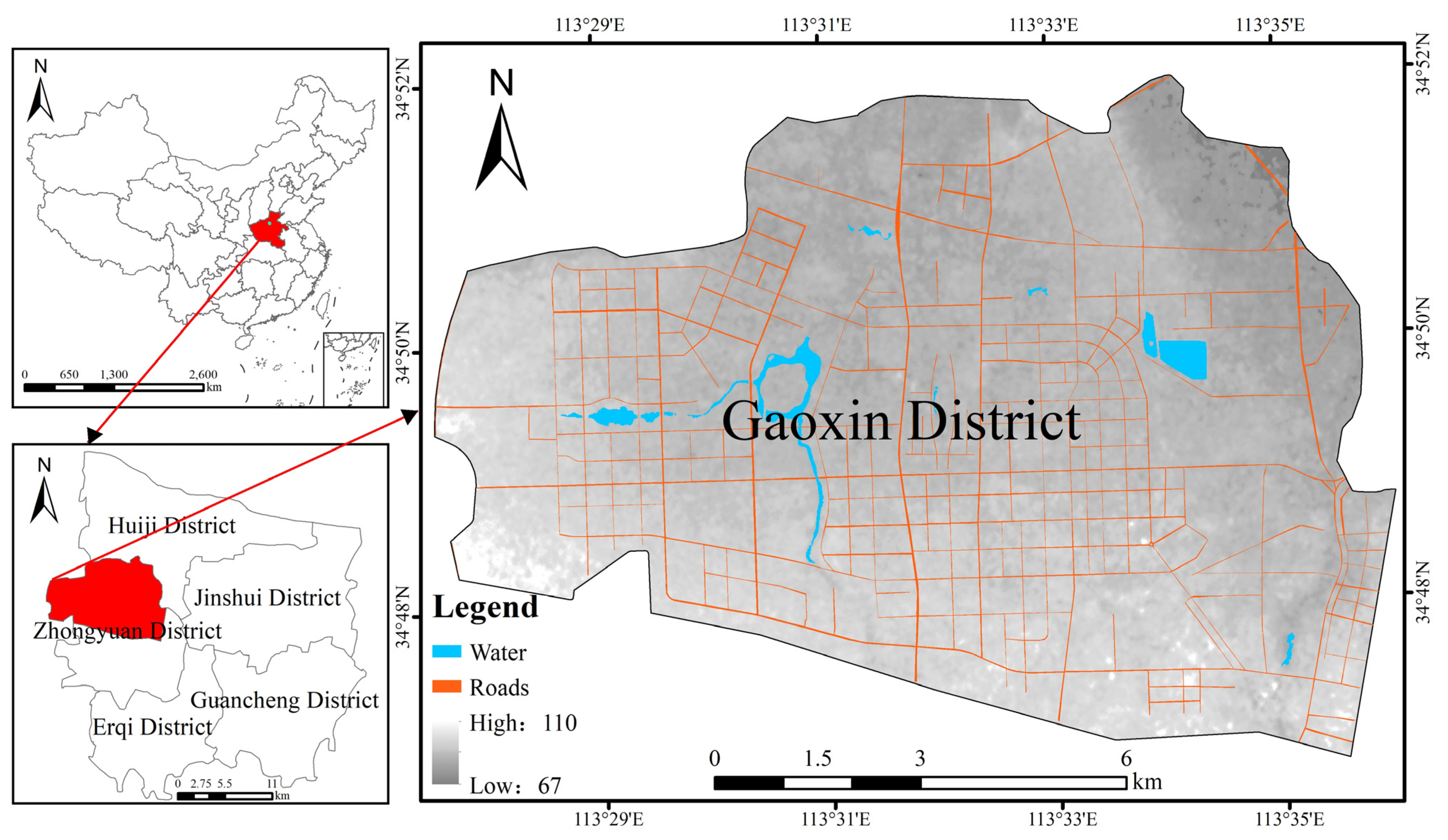

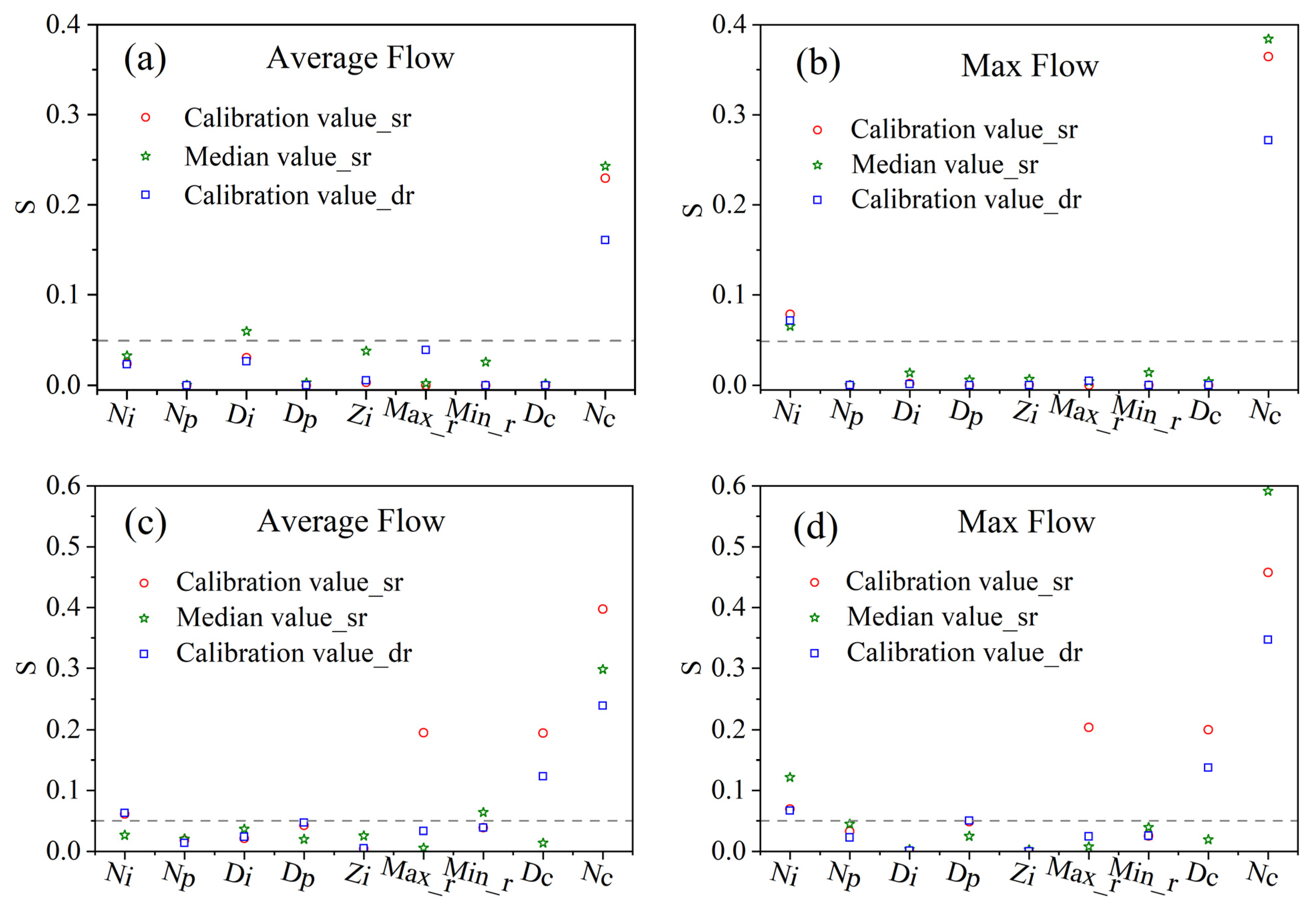
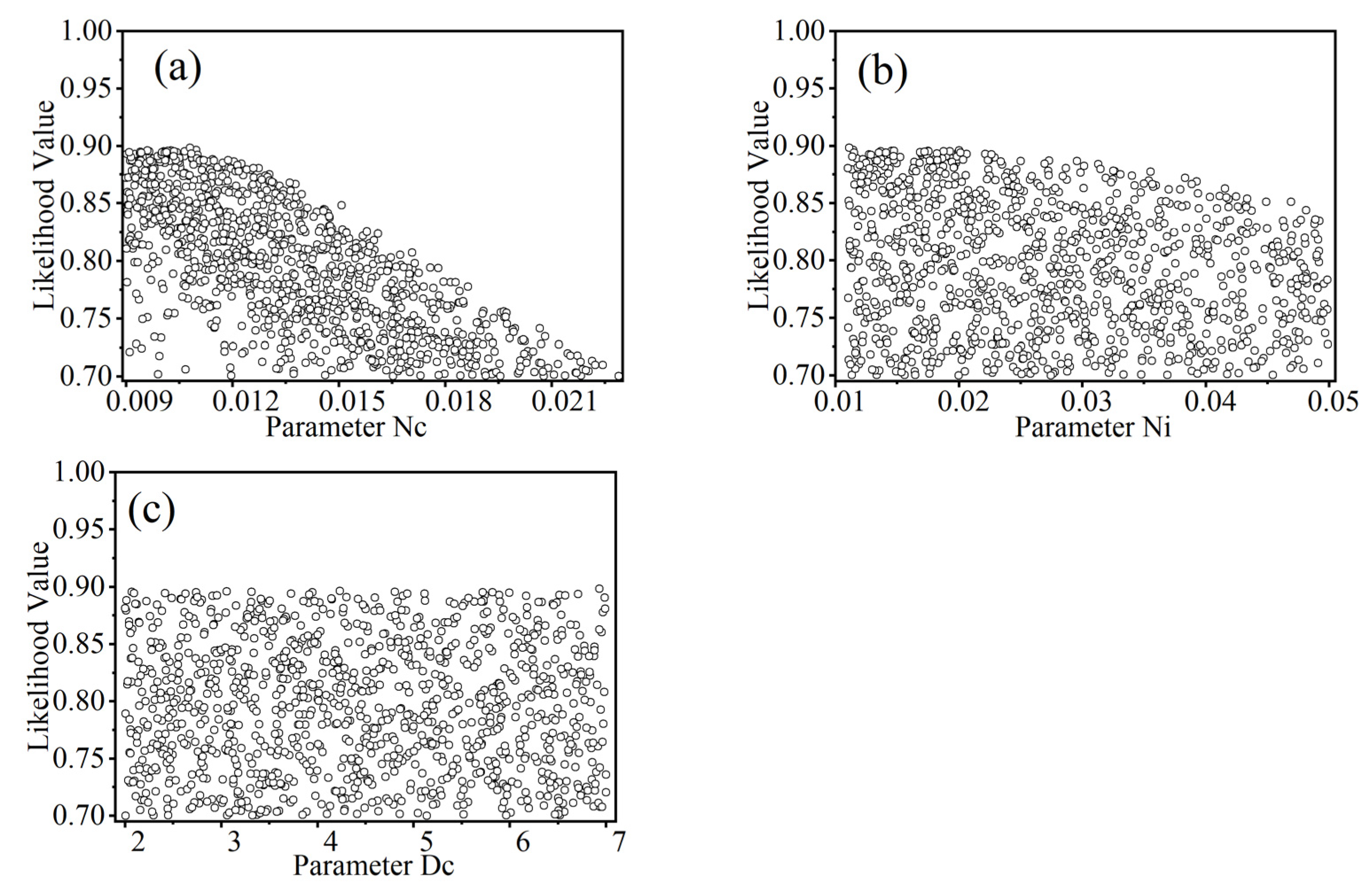
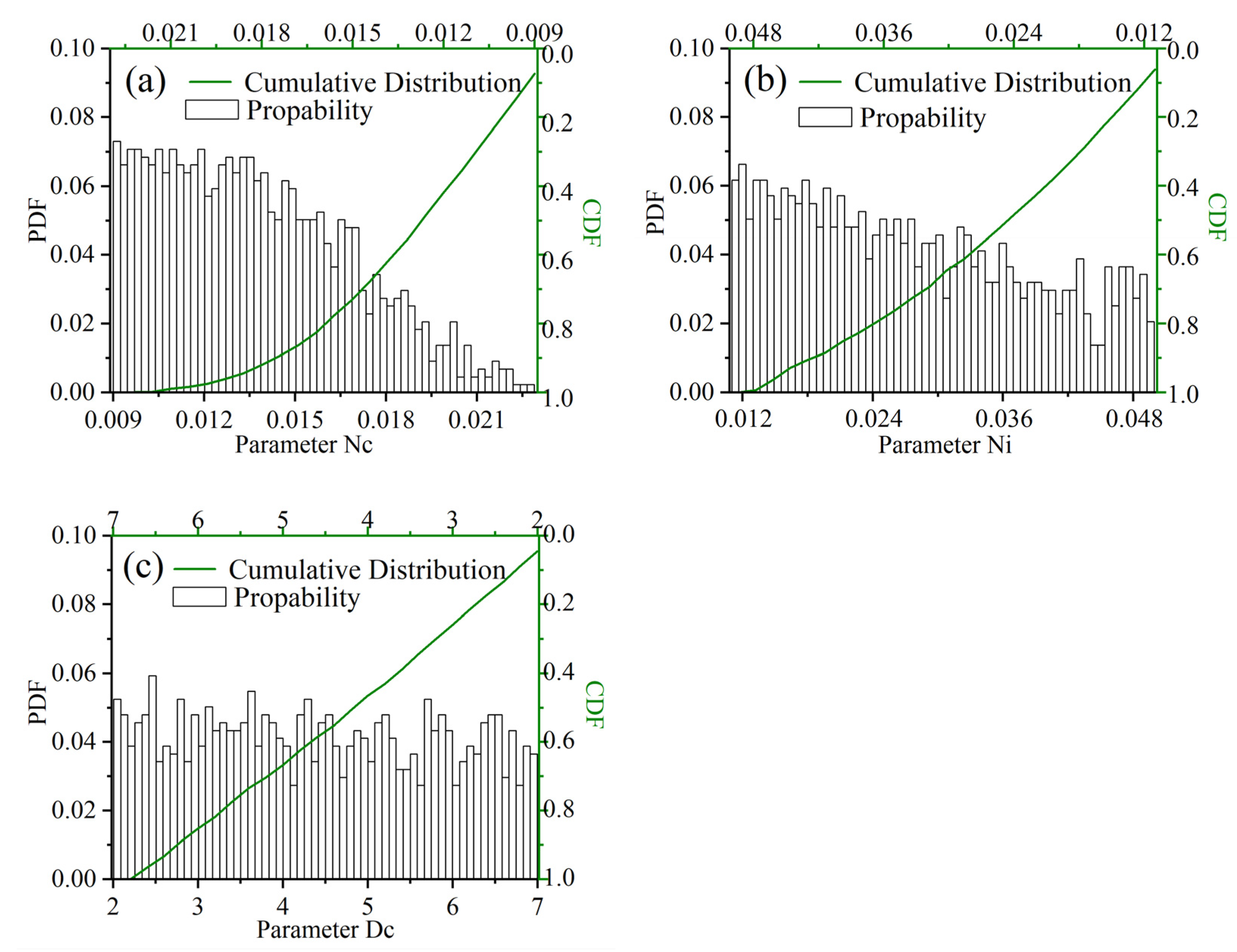

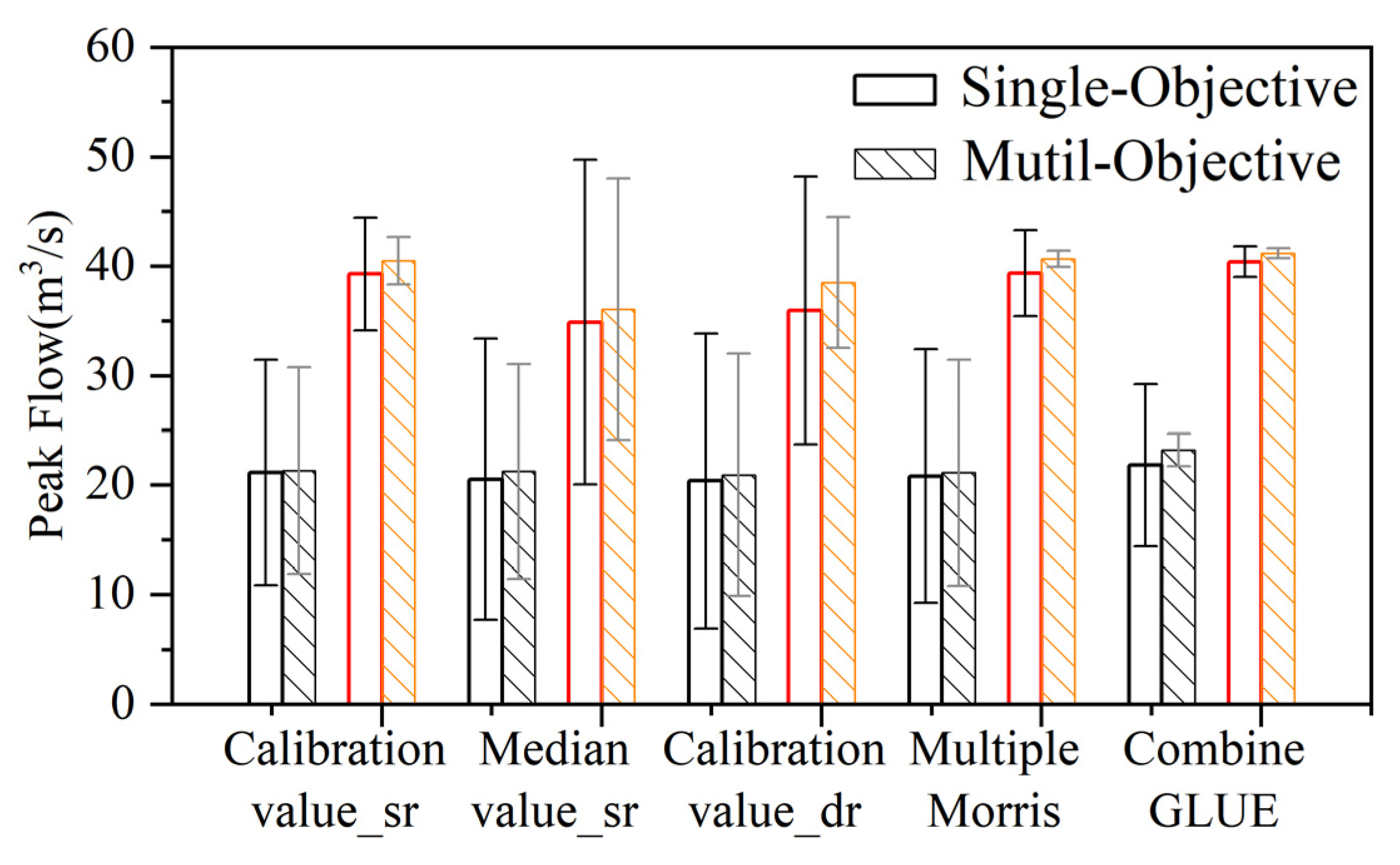

| Symbol | Parameter | Description | Domain |
|---|---|---|---|
| Ni | N-imperv | Manning’s n for impervious areas | (0.011, 0.05) |
| Np | N-perv | Manning’s n for pervious areas | (0.01, 0.8) |
| Di | Destore-imperv | Depression storage for impervious areas (mm) | (0.2, 10) |
| Dp | Destore-perv | Depression storage for pervious areas (mm) | (2, 10) |
| Zi | Zero-imperv | Percent of impervious area without depression storage (%) | (5, 85) |
| Max_r | Maxrate | Maximum infiltration rate (mm.h−1) | (20, 127) |
| Min_r | Minrate | Minimum infiltration rate (mm.h−1) | (0.1, 10) |
| Dc | Decay-constant | Infiltration attenuation coefficient (h−1) | (2, 7) |
| Nc | N-conduit | Manning’s n for conduits | (0.009, 0.024) |
| Event | Data | Total Rainfall (mm) | Duration (h) | Time Step (h) | Max Intensity (mm/h) |
|---|---|---|---|---|---|
| 0819 | 19 August 2018 | 41.5 | 13 | 1 | 11 |
| 0515 | 15 March 2018 | 64.5 | 12 | 1 | 26.5 |
| 0801 | 1 August 2018 | 63 | 2 | 1 | 60 |
| 0730 | 30 July 2017 | 34.5 | 12 | 1 | 7.5 |
| Group | 0819 | 0515 |
|---|---|---|
| Calibration value_sr | Nc, Ni | Nc, Dc, Max_r, Ni |
| Median value_sr | Nc, Ni, Di | Nc, Ni, Min_r |
| Calibration value_dr | Nc, Ni | Nc, Ni, Dc |
| Multiple Morris | Ni, Di, Nc, Zi, Max_r, Min_r | Nc, Dc, Ni, Max_r, Min_r, Dp |
| Parameter | Mean | σ | Cov | Correlation Coefficient, R | ||
|---|---|---|---|---|---|---|
| Nc | Ni | Dc | ||||
| Nc | 0.014 | 0.003 | 23% | 1 | ||
| Ni | 0.027 | 0.011 | 40% | −0.32 | 1 | |
| Dc | 4.412 | 1.444 | 33% | −0.03 | 0.01 | 1 |
| 0819 Parameter | Before Calibration | After Calibration | 0515 Parameter | Before Calibration | After Calibration |
|---|---|---|---|---|---|
| Ni | 0.013 | 0.0207 | Ni | 0.013 | 0.021 |
| Di | 2.54 | 5.1 | Dp | 7 | 5.9 |
| Zi | 0 | 47.6 | Max_r | 114.4 | 116.4 |
| Max_r | 114.4 | 27.5 | Min_r | 3.8 | 1.3 |
| Min_r | 3.8 | 0.7 | Dc | 2 | 4 |
| Nc | 0.01 | 0.011 | Nc | 0.01 | 0.012 |
| Rainfall Event | Method | Peak 1 Error (%) | Peak 2 Error (%) | ||
|---|---|---|---|---|---|
| Single-Objective | Multi-Objective | Single-Objective | Multi-Objective | ||
| 0819 | Calibration value_sr | 11.42 | 11.26 | 22.66 | 22.61 |
| Median value_sr | 12.17 | 11.71 | 22.76 | 22.72 | |
| Calibration value_sr | 11.51 | 11.27 | 22.55 | 22.39 | |
| Multiple Morris | 5.22 | 3.09 | 8.77 | 3.71 | |
| Combine GLUE | 3.77 | 0.36 | 5.36 | 2.18 | |
| 0515 | Calibration value_sr | 10.30 | 9.44 | 5.14 | 2.17 |
| Median value_sr | 12.83 | 9.81 | 15.72 | 12.83 | |
| Calibration value_sr | 13.46 | 11.08 | 13.12 | 6.95 | |
| Multiple Morris | 11.60 | 10.31 | 4.90 | 1.76 | |
| Combine GLUE | 7.40 | 1.49 | 2.40 | 0.57 | |
| 0801 | 0819 Parameter | 0.89 | |||
| 0515 Parameter | 7.77 | ||||
| 0730 | 0819 Parameter | 3.34 | 6.31 | ||
| 0515 Parameter | 0.66 | 12.46 | |||
Disclaimer/Publisher’s Note: The statements, opinions and data contained in all publications are solely those of the individual author(s) and contributor(s) and not of MDPI and/or the editor(s). MDPI and/or the editor(s) disclaim responsibility for any injury to people or property resulting from any ideas, methods, instructions or products referred to in the content. |
© 2022 by the authors. Licensee MDPI, Basel, Switzerland. This article is an open access article distributed under the terms and conditions of the Creative Commons Attribution (CC BY) license (https://creativecommons.org/licenses/by/4.0/).
Share and Cite
Zhong, B.; Wang, Z.; Yang, H.; Xu, H.; Gao, M.; Liang, Q. Parameter Optimization of SWMM Model Using Integrated Morris and GLUE Methods. Water 2023, 15, 149. https://doi.org/10.3390/w15010149
Zhong B, Wang Z, Yang H, Xu H, Gao M, Liang Q. Parameter Optimization of SWMM Model Using Integrated Morris and GLUE Methods. Water. 2023; 15(1):149. https://doi.org/10.3390/w15010149
Chicago/Turabian StyleZhong, Baoling, Zongmin Wang, Haibo Yang, Hongshi Xu, Meiyan Gao, and Qiuhua Liang. 2023. "Parameter Optimization of SWMM Model Using Integrated Morris and GLUE Methods" Water 15, no. 1: 149. https://doi.org/10.3390/w15010149
APA StyleZhong, B., Wang, Z., Yang, H., Xu, H., Gao, M., & Liang, Q. (2023). Parameter Optimization of SWMM Model Using Integrated Morris and GLUE Methods. Water, 15(1), 149. https://doi.org/10.3390/w15010149










